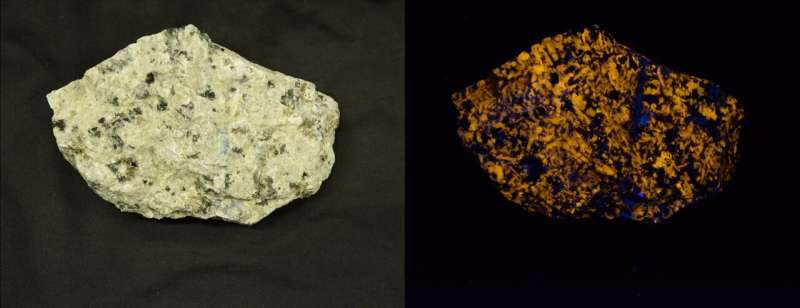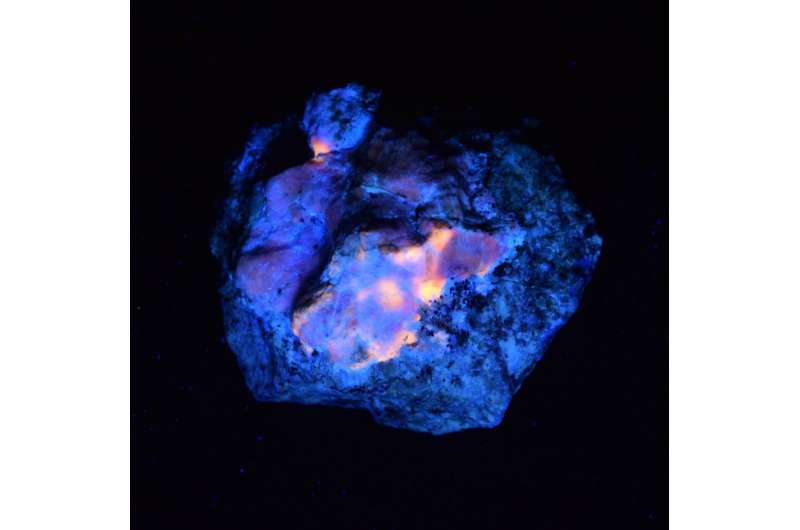Glow-in-the-dark hackmanite. Credit: Mika Lastusaari
Scientists at the University of Turku, Finland, have discovered the origin of the glow in the natural mineral that generates white luminescence in the dark. By studying natural minerals, significant new knowledge can be gained for the development of better synthetic materials.
Glow-in-the-dark materials, or materials with an afterglow, are known to everyone at least from the self-lit emergency exit signs. Materials with an afterglow are also used for various other purposes, such as bioimaging.
"The materials used at the moment are all synthetic, and, for example, the material with the familiar green afterglow obtains its glow from an element called europium. The difficulty with this kind of materials is that even though the desired element that emits luminescence can be added to them, their afterglow properties cannot be predicted," notes University Lecturer Mika Lastusaari, the head of photonics research at the Inorganic Materials Chemistry research group at the University of Turku.
There are also some natural minerals capable of afterglow. One such mineral is hackmanite which can be found in Afghanistan, Greenland, Canada and Pakistan. However, all hackmanites are not capable of glowing in the dark.
"We have conducted a lot of research with synthetic hackmanites and have been able to develop a material with an afterglow distinctly longer than that of natural hackmanite. However, the conditions affecting the luminescence have been unclear so far," explains Postdoctoral Researcher Isabella Norrbo from the research group.
Hackmanite that shows luminescence but does not have an afterglow. Photo on the right has been taken in UV light. Credit: Mika Lastusaari
"Nature has extensive experience in optimizing minerals, which is why we used natural hackmanites to study the afterglow effect," adds Doctoral Candidate Sami Vuori from the research group.
Natural minerals often contain complex compositions and rather major composition differences depending on the conditions they were formed in.
"Optimizing natural materials gives us a possibility to discover how hackmanites generate the most effective glow," says Doctoral Candidate Cecilia Agamah.
Titanium Makes Hackmanite Glow
The study was carried out as an international collaboration between scientists from different fields. In addition to chemists, the study involved mineralogists, geologists, physicists, a statistician and scientists specialized in modeling material properties.
"Through this extensive collaboration, we were able to come to a conclusion that the most central elements behind the glow of natural hackmanite are sulfur, potassium, titanium and iron, and the correct balance of their concentrations," says Mika Lastusaari.
Hackmanite with an afterglow and extremely versatile composition. Photo taken in UV light. Credit: Mika Lastusaari
By combining experimental and computational data, the study managed to prove that titanium glows at the core of hackmanite, and the afterglow is related to the transfer of electrons in the conduction band.
"With these results, we obtained valuable information of the conditions affecting the afterglow of hackmanites. Even though nature has not, in this case, been able to form a material with a glow as effective as in synthetic materials, nature has helped significantly in the development of increasingly more effective glowing materials," explains Lastusaari.
More information: Cecilia Agamah et al. Hackmanite—The Natural Glow-in-the-Dark Material, Chemistry of Materials (2020). DOI: 10.1021/acs.chemmater.0c02554
Journal information: Chemistry of Materials
Provided by University of Turku

























